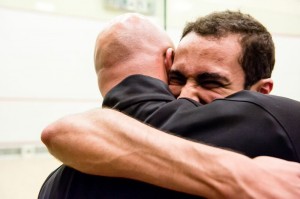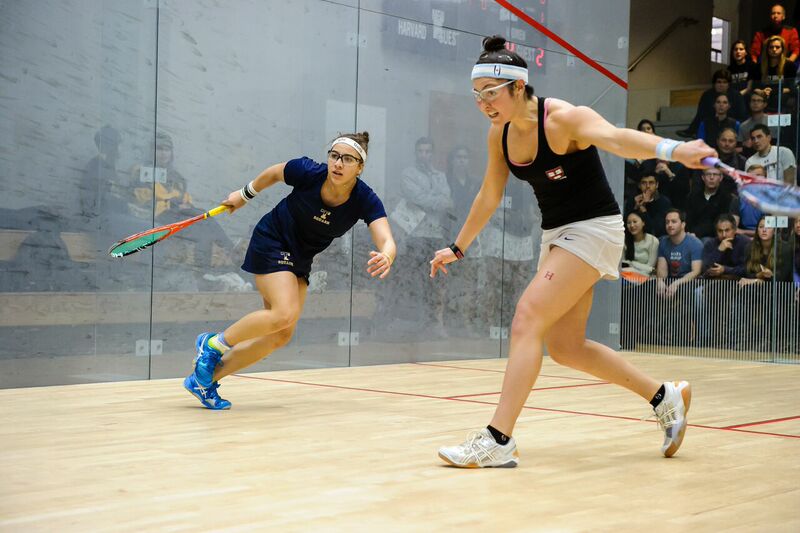
By Nell Schwed
In a season dominated by close competition and surprise score lines, the CSA National Championships proved to be the perfect stomping ground for retribution, legacies revived, and new claims staked.
The Women’s National Team Championships kicked off February 13-15 at Harvard University with hometown favorites and national No. 1 Harvard leading the pack. All four top teams—Harvard, Penn, Trinity, and Princeton respectively—bested their lower-ranked competition in dominant 9-0 matches. During the semifinals, Trinity and Harvard were fated to meet once again in the finals after close-calls with 5-4 scores against their fellow Ivy League competition, Penn and Princeton.
Last year, the Trinity women disrupted Harvard’s third consecutive attempt at the national title, besting their Cambridge foes in a hotly contested 5-4 win. Of the nine matches played, only one—the number one position played by Harvard’s Amanda Sobhy and Trinity’s Kanzy El Defrawy—did not reach extra games; the remaining eight matches were evenly split between four and five game battles (Many of those games were won by scores of 12-10 and 13-11). This year however, Harvard did not give their third-seeded rivals any room to take the Howe Cup back to Hartford.
Harvard came out firing in the first round of matches—taking an early 4-1 lead—and closed out the match with a 7-2 final score, falling short only at the No. 2 and 9 positions in four and five game matches, respectively. Sobhy, one of the winningest college players of all time, closed out her college squash career undefeated. (Sobhy dropped just two games in her four year stretch—in 2013 to El Defrawy in Harvard’s final non-conference match of that regular season, and the weekend of this most recent individuals where Sobhy dropped the first game 9-11.)
The final of the Men’s National Team Championships, played the following weekend, made squash history—it was the first time that a championship final did not feature an Ivy League contender, but rather two liberal arts schools—one part of the New England Small College Athletic Conference (NESCAC), the other a member of the Liberty League Athletic Conference.

Trinity, facing the No. 2 seeded St. Lawrence, with home court advantage at the Kellner Squash Center, left little doubt as to which team was most deserving of the national title. Trinity bested the Saints 7-2, the individual game scores tight—with five Bantams winning their matches in three games, whereas four others clinched their extra game battles (one four-game match, four five-gamers) to seal the team win.
Of the Trinity men’s eighteen national finals appearances, they have won all but three of them. Paul Assaiante, the winngest coach in college squash history, has led his team to fifteen national titles (so far) and held the most dominant streak in college sports history with 252 consecutive wins. (The streak came to an end when Yale downed Trinity in a tight 5-4 at the 2012 Men’s National Championships.)
Tension between Ivy League athletics and those of other squash-playing-schools—including varsity, club and emerging teams—has always been a hot-button issue surrounding recruiting, access to the game, and “homegrown” American squash versus the international stage. But in 1996, a “fateful” meeting—in Coach Assaiante’ s own words—occurred between Coach and then-president of Trinity College, Evan Dobelle.
Dobelle wanted to know: what would it take to have a top squash program? How could Trinity, a NESCAC, compete with the Ivies?
Though it seems international recruiting—pulling players from parts of the world that had been playing softball squash much longer (and more prevalently) than Americans—has been the answer, inspiring other schools to do the same; it has also been a dedication to the sport, a commitment and drive to see it become something larger and more competitive, that has catapulted non-Ivy League teams onto the squash stage.
Of the thirty-two top teams competing in the men’s and women’s divisions (Potter and Hoehn for men, Howe and Kurtz for women), a little over half are non-Ivy league schools. Not only does this demonstrate growth of squash in other athletic conferences, but also the rising number of teams in existence. There were more varsity, club and emerging teams populating all divisions this year—just ten years ago there were hardly enough for a full bracket in the E division—which lends more opportunities to upset the Ivy hold on squash rankings, or improve on the growth that already exists.
The weekend of the CSA Individual Championships, February 27-March 1, closed the college season until November. The individuals featured four divisions—two for men: Pool and Molloy; two for women: Ramsay and Holleran—and accounted for a total of 160 players, and again demonstrated burgeoning rivals to the Ivy League, with two finalists in the top divisions (Pool and Ramsay) from NESCACs.
Sobhy, American world No. 10, ended her college career undefeated, and was the second player in squash history to win four consecutive individual titles. (Gail Ramsay, current Princeton women’s squash coach, was the first, and presented her namesake trophy—the Ramsay Cup—to Sobhy on finals day.)
Trinity’s El Defrawy, Egyptian world No. 50, met Sobhy in the finals of the individuals for the third consecutive year. Sobhy and Defrawy have met eight times on the college circuit, once in a sanctioned Women’s Squash Association event, and previously in the 2009 World Junior Championships. El Defrawy has won only one of those previous meetings. Unfortunately for the Trinity junior, the opportunity to best Sobhy in the college arena slipped through her fingers—despite her numerous dives.
It was open season in the men’s division this year, as no player in the draw had previously made the final of the Individual Championships. St. Lawrence’s Amr Khaled Khalifa, champion in 2013, and Columbia’s Ramit Tandon, semifinalist in 2014, dropped out of the draw just a few days before the tournament—shifting seedings to benefit those ranked below.
Ahmed Abdel Khalek, a Bates junior, came back from a 0-2 deficit to defeat Columbia freshman Osama Khalifa (brother of St. Lawrence’s Amr) for the Pool Trophy and Men’s National Individual Championship. Both Khalek and Khalifa propelled themselves into the finals by besting their previous opposition in three games, much like their fellow players in the Ramsay division.
Khalek’s win marks his first intercollegiate individual championship title, and a first men’s national individual championship for Bates.
The season ended on a high note for two teams who lost longtime coaches—Princeton’s Bob Callahan and Middlebury’s John Illig—by winning their respective divisions, Hoehn and Summers, on the men’s side of play.
Many teams experienced national firsts for their respective squash programs: the Vassar men won the H Division (only in its second year), the Stanford women won the Kurtz Cup, and the Dickinson men—in their initial year as a varsity program—won the E Division.


